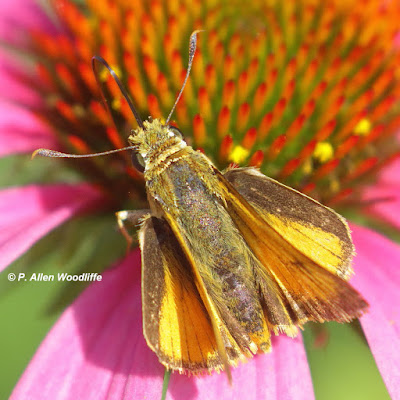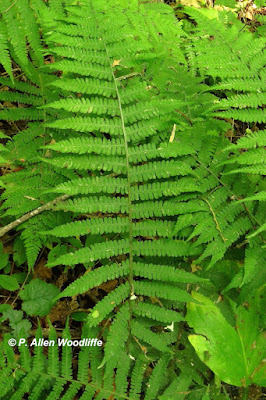Collecting data for the current Ontario Breeding Bird Atlas is beginning to wind down. Not that there won't be some birds in nesting mode for a few weeks yet. One year I was able to photograph a nest full of Cedar Waxwings as late as the first week of September! But for many birds, things are more likely to be gearing up for migration, which for some shorebird species, is already underway.
I've been out several times over the last few days. And as usual, even though I'm more or less focusing on birds, there are so many other things to be distracted with.
On one occasion I was out at the McKerrall Forest, a few kilometres north of Chatham. The birds weren't overly vocal, at least for my ears. I mostly saw or heard the usual woodland species, but did get a good, but distant look at a male Orchard Oriole.
I'm not really 'into' sedges, but this one usually gets my attention. It is called Gray's Sedge, a relatively common woodland species.If I come across American Beech trees, I check for Beech Leaf Disease, an insidious relatively new disease that may play havoc with any beech trees that have survived other stresses. The disease is relatively identifiable with its dark, blackish bands in between the leaf veins.
When I got to the one end of the forest, I looked out across the bean and wheat field, and noticed a couple of ears sticking up. They quickly morphed into the head of this deer.
....always keeping an eye on me, but eventually emerging almost totally. However when I finally moved, it decided enough was enough, and so it quickly bounded away to the woodlot at the far side of the field.
I've also been on the CASO trail again, which I described in some detail in my previous post. The light wasn't great, and I didn't get any bird photos. I was able to update or confirm breeding for a few species. I also took note of more of the developing plants along the corridor. Here are a couple of quite frequently encountered ones, and not surprisingly, both are non-native.
 |
| Chicory |
 |
| Globe Thistle |
I also had the opportunity to visit Moravian First Nation, also known as the Delaware Nation of the Thames. My friend Darren, a member of this Delaware Nation, had invited me out to explore some parts of it. In part he wanted to show me the devastation by the Gypsy Moths, which can almost totally defoliate a tree. It is certainly at a peak of their 7-10 year cycle, and early in the season the effects can be quite worrisome. However the trees seldom die, but after the hatch of larvae have done their deed in devouring the new leaves, the tree will leaf out, but with smaller leaves.
 |
| Gypsy Moth larva |
The adults don't live for very long, just a few days. Even though the female, shown here with the lighter colour, has wings, it seldom flies. It emits a pheromone to attract a male, and mating can take place for up to an hour.
On a brighter note, we checked one of the populations of Heart-leaved Plantain, a legally endangered species. It flowers in mid to late spring, and at this time of year, only the leaves are visible.
Heart-leaved Plantain looks a lot like another wetland species: Skunk Cabbage, which is fairly common throughout wet woods in southern Ontario. Here the two species are side-by-side, with the plantain on the left and the cabbage on the right.
Another highlight was to see a large stand of Pawpaw, one of the largest stands I have ever seen. Some individuals were almost 40 feet high. I use the term individuals lightly, while they appear as individual stems above ground, it quite likely is one very large clone.
Another nice find was this Silvery Spleenwort, a somewhat rare woodland fern.
It is identified by its long fronds, and especially by the silvery sori on the underside of the leaves.
Late last week I received a phone call from a friend, who heard a bird call he couldn't identify. Even while he was talking on the phone, I could hear what I thought was a Northern Bobwhite calling. Marie and I went out to see, but the bird had gone quiet, and even after almost an hour, it did not call, so we left. No sooner had I gotten home when Marcel called again to say it was back, so back I went. The bird was calling from the trees in the front yard, and after a very few minutes, I located the bird in the thick of a birch tree. The backlit bird against a rather bland sky made it a challenge to photograph and process.
This is an endangered species also and there were several factors making it difficult to advertise this bird. While I was assessing this conundrum, I found out that it was a released bird, so birders intent on adding this to their list really had no reason to check it out, since only wild birds are considered legitimate.
On Saturday I re-visited the Dealtown Crown Land Prairie. It isn't the easiest place to get to, but well worth it if you like grassland and shrubland birds, as well as lots of tallgrass prairie plant species. The prairie site was established in the early 1990s as a tallgrass prairie species seed nursery. Seeds produced here were harvested and used for various prairie planting in the tri-county area and beyond. It was used for a few years, but then the seed nursery was situated at a better place in Lambton so this site was left alone. While the diversity remains intact, it is becoming much more shrubby, and is in dire need of a prescribed burn. There is lots of grasses of the tallgrass prairie type and when they are as dense as they can be, the vegetation is quite wet. I was soaked well above the knees in fairly short order. Such is the life of prairie trampers!
Immediately upon getting past the forest and entering the prairie site, I was met with this stand of Purple Coneflower. While it is an impressive species, and certainly native to the mid-western tallgrass prairies, it is not native to Ontario. It is most definitely popular with gardeners, however, and shows up in many places.
The butterflies enjoy nectaring on this species.
 |
| Hobomok Skipper |
Climbing Prairie Rose is a species designated as 'Special Concern' in Ontario and Canada. It was planted here more than two decades ago.
Compass Plant, another rarity, is thriving here.....
...the relatively small and less conspicuous Flowering Spurge is nice to see.
Grey-headed Coneflower is scattered throughout.
Swamp Milkweed is not limited to prairies or swamps, which is fortunate for the many butterfly species that come to visit it.
Wild Bergamot is also scattered here and there.
As for birds, I found a few to upgrade or add to the overall list, including things like Field Sparrow, and Northern Mockingbird, but I didn't get any photos of either of them. I did have this Eastern Kingbird sit up in an open spot.
I was a little surprised to see this Green Heron hanging around, but they seem to be more plentiful than usual in the area this year.
I had hoped that I might find and photograph a Dickcissel, which was relatively common here during the invasion of 2017. Fairly early in my meanderings here I did hear one. Usually they sit up in nice view, but the area I heard it from was quite shrubby. I eventually was able to see through a gap in the shrubs and find this individual on an open branch, but lower than I usually expect it.
It eventually moved to what I consider a more typical spot, and fortunately the light and background made it a quite successful photo op. I saw two males at this site, but no females, so presumably (hopefully!) they might be on a nest.
Additional note: Please be advised that if you are a subscriber to this blog, the blog site has indicated that sometime after July it will no longer be providing automatic email notices of when this blog is published. I will try and get a subscriber's list assembled and let you know, but in the meantime, if you would like to be advised of the publication of future posts of Nature Nuggets, let me know via this email: prairietramper@gmail.com.
The blog post appears to still have the email subscription function. The blog feeder has just indicated that it will discontinue after July.


































No comments:
Post a Comment